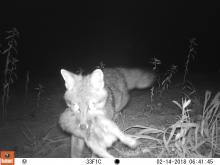Background:
Population genetic structure is generally used to depict population subdivision based on genetics studies. Ideally, no genetic structure should be detected in a single mendelian population because every individual is hypothesized to move freely without any physical, genetic, or social preference and to mate randomly (Hamilton, 2009, p.105). However, this does not hold true for actual populations because complex restrictions and preferences. (e.g., the mating chance of two individuals often depends on their location. Hamilton, 2009).
Road-induced genetic divergence among populations or among segments of a population has been documented for many vertebrate species. This effect probably depends on road type and use. Gerlach & Musolf (2000) found that a recent highway (~25 years-old) contributed to a significant population subdivision of bank vole (Clethrionomys glareolus), while other road barriers including an old railway (~50 years-old) and a rural road (~25 years-old) did not. Despite many studies of road-crossing effectiveness by wildlife, individual animal crossing of roads may not be sufficient to guarantee the persistence of an entire population, because a species-specific minimum number of individual movement is required to assure gene flow (Corlatti et al., 2009). Developed urban and agricultural areas can also fragment populations. Even for a highly mobile bird, the golden-cheeked warbler (Dendroica chrysoparia), the isolation caused by agricultural lands clearly caused one population to diverge from other sampling populations (Lindsay et al., 2008). It is not known many migrants per generation must cross roads to counteract the effect of fragmentation or genetic drift. This issue has not been resolved for wild populations in a generally applicable way (Holderegger & DiGiulio, 2010).
Objectives:
Our objectives are to determine whether major highways in California, SR 50 and I-80 in the Sierra Nevada and I-680, and I-580 in the Bay Area, disrupt connectivity of ground dwelling terrestrial mammal populations. In this preliminary study we will use coyote as a model to determine whether highways affect dispersal patterns and reproductive success of mesopredators.
Specifically, we aim to:
- Collect genetic samples from coyotes on either side of highways SR 50, I-80, I-580, and I-680
- Use landscape genetic tools to determine whether these highways SR 50, I-80, I-580, and I-680act as barriers to coyote gene flow.
(Funded by the National Center for Sustainable Transportation)

